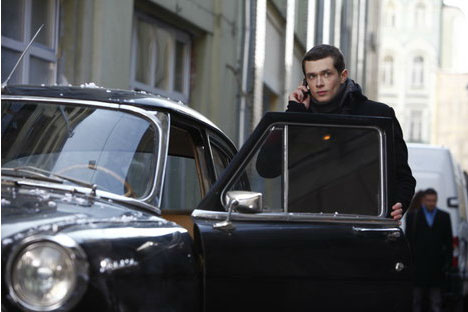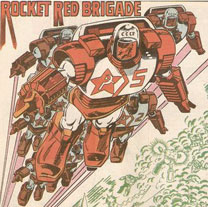
“Black Lightning,” the most recent, authentic and promising cinematic appearance of a Russian superhero to date. Source: kinopoisk.ru
“It is a common mistake to assume that the existence of superheroes is a purely American phenomenon. Superheroes are an integral part of the Russian cultural tradition,”— said director, producer and script-writer Timur Bekmambetov.
The superheroes that we see on the big screen today are simply a continuation of each culture’s particular mythological traditions—albeit exaggerated by cinematic means and the use of special effects. Superman is a modern-day Hercules. Batman is a male version of Greek mythology’s Erinyes, and we have globalization to thank for Hollywood taking Thor, the Norse God of thunder, and transporting him to the dusty deserts of New Mexico.
So, if we are to take Bekmambetov’s words at face value, then it would be no surprise if we were soon to see the legendary Sadko repackaged as a Russian Namor the Sub-Mariner, or a group of well-built “bogatyrs”allying to form a team of superheroes, or Baba Yaga clad in fishnet stockings flying around in her mortar over Moscow’s skyscrapers. Let’s hope we do.
There is a look at the most noteworthy Russian superheroes to have appeared on the big screen and television—both in Russian films and in those produced by international teams attracted by the local color.
“Black Lightning”(2009)
“Black Lightning”is the most recent, authentic and promising cinematic appearance of a Russian superhero to date. The film was directed by Alexander Voitinsky and Dmitry Kiselyov, and it was produced by the very same Timur Bekmambetov.
The story follows a student named Dmitry (played by Grigory Dobrygin) who has a crush on a female classmate—but she appears to be more interested in another guy, who just happens to own a brand new Mercedes.

Boy turned in a superhero with his Volga car. Source: kinopoisk.ru
Dmitry receives a dilapidated 1966 GAZ 21 Volga for his birthday, although he had been hoping for something much better. Later, he discovers by chance that his car is actually a military experiment that can fly. So he becomes a superhero to defend Moscow from the forces of evil… and to avoid the city’s legendary traffic jams.
According to Voitinsky, the message of the film is: “A hero can be found in every one of us. And when life throws us a challenge, it turns out that we are so full of strength and love that evil doesn’t stand a chance.
The spectacular CGI and special effects were provided by Bazelevs Productions, which also worked on the films “Night Watch”and “Day Watch,” as well as Bekmambetov’s feature-length Hollywood debut, “Wanted.”
Official trailer. Source: Youtube
Watch “Black Lightning” in Russian here.
Ilioukhine
Ilioukhine is a cyborg-superhero that has the ability to transform into various types of aircraft during battle. The character—whose name was inspired by the Soviet-era Ilyushin aircraft manufacturer and who is also known asComrade Turbinski—was created by writers for the Japanese manga “Kinnikuman Nisei” and its anime-series adaptation. The series was broadcast in Japan, the United Kingdom and the United States at the beginning of the 2000s.
See the hero in action:
Kinnikuman Nisei, episode 6. Source: Youtube
Linka
Linka was a character from the U.S. animated series “Captain Planet and the Planeteers”(1990–1996) created by Ted Turner. The cartoon, which has a strong environmental message, tells the story of Gaia—the spirit of the Earth—who sends five rings with the power to control the elements to five children around the world.
A clip from the episode “Mind Pollution.” Source: Youtube
Linka was the chosen one from the Soviet Union (though this was later changed to Russia after the collapse of the Soviet Union on December 8, 1991) and was given the power to control the wind. She studies bird life closely and becomes very emotional when they are affected by pollution. She was also a master of strategy and logic. Sometimes Linka used Russian phrases, the most common one being “Bozhe moi!”(Oh My God!), which she would say when she was surprised. She was perhaps the first Russian superhero with her own action figure.
Red Star
Red Star, whose real name is Leonid Konstantinovich Kovar, first appeared under the name Starfire in the “Teen Titans”comic published by DC Comics in the United States.
 |
| Red Star. Source: Press photo |
When he was a young teenager, Leonid and his father, who was an archeologist, were investigating a spaceship that had crashed into the Yenisei River. The ship exploded, imbuing him with superhuman energy, strength and speed, and the ability to create fire by thought (known as “pyrokinesis”).
An ardent patriot and firm believer in communism, Leonid offered his services to the Soviet Union and, in 1982, became the first Russian superhero in the DC Universe. Predictably, he meets Valentina Vostok—superhero name Negative Woman—a Soviet pilot who defected to the United States.
The character appeared regularly on the animated version of “Teen Titans”broadcast on Cartoon Network (beginning July 19, 2003), where he is depicted as living in an abandoned nuclear power plant in Siberia in order to control his alien radiation, the power of whose emissions depends on his mood.
Watch a clip from Episode 57 of “Teen Titans”(original with Spanish subtitles)
Rocket Red
Three characters have borne the name Rocket Red in the DC Universe since 1987: the original Rocket Red (an android), followed by Dmitri Pushkin and, finally, Gavril Ivanovich.
 |
| Rocket Red. Source: Press photo |
Dmitri Pushkin was a Russian lover of American culture who obtained permission from the Soviet Union for his wife and two children to live with him at the Justice League’s Paris embassy. He ends up sacrificing his own life in order to save those of his fellow Justice League members.
In 2010, Gavril Ivanovich, yearning for the old Soviet times, appeared to replace Pushkin. He managed to win the respect of his teammates quickly, despite his poor English and his outdated battle armor.
His superpowers, which always depended on his poorly built battle suit, included super strength, invulnerability, rocket-powered flight, the ability to project powerful energy blasts, and “mecha-empathy”—the ability to communicate with and control computers and machines.
Despite this impressive list of superpowers, Gavril Ivanovich is killed in an attack. He is brought back, however, in various episodes of the “Justice League Unlimited” animated TV show, which was also shown on Cartoon Network. He has his own action figure made by Mattel.
Rocket Red at Justice League Unlimited. Source: Youtube
Molotov Cocktease
An ex-gymnast and former Soviet agent, Molotov Cocktease is, in many ways, a parody of Bond girls. Appearing on Cartoon Network’s “The Venture Bros.,” she spends most of the series in a chastity belt because of a promise she made to her father.
A clip from “The Venture Bros.”with Molotov Cocktease. Source: Youtube
Colossus
Colossus (whose real name is the rather thought-provoking Piotr Nikolaievich Rasputin) is the Russian mutant member of Marvel’s extremely popular X-Men.
Colossus was born on a collective farm in Ust-Ordynski near Lake Baikal in Siberia. He was recruited to the X-Men by Professor Charles Xavier after he saved his sister from dying in an accident involving a broken tractor.
Colossus has the ability to transform his entire body into “organic steel,” becoming the strongest member of the X-Men when doing so. His brother, Mikhail, was a cosmonaut before he died in an accident. In one of the comic books, it is revealed that Piotr is indeed a descendent of Grigori Rasputin.
Canadian actor Daniel Cudmore played Colossus in “X2” (2003) and “X-Men: The Last Stand”(2006). He appears set to star in the upcoming “X-Men: Days of Future Past,” due for release next year.
All rights reserved by Rossiyskaya Gazeta.
Subscribe
to our newsletter!
Get the week's best stories straight to your inbox